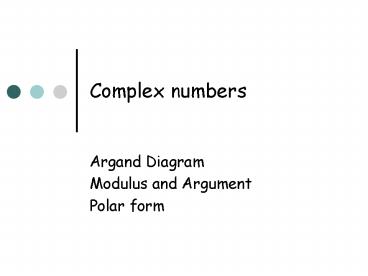Complex numbers PowerPoint PPT Presentation
1 / 11
Title: Complex numbers
1
Complex numbers
- Argand Diagram
- Modulus and Argument
- Polar form
2
Argand Diagram
- Complex numbers can be shown Geometrically on an
Argand diagram - The real part of the number is represented on the
x-axis and the imaginary part on the y. - -3
- -4i
- 3 2i
- 2 2i
Im
Re
3
Modulus of a complex number
- A complex number can be represented by the
position vector. - The Modulus of a complex number is the distance
from the origin to the point. - Can you generalise this?
- z v(x2y2)
Im
y
x
Re
How many complex numbers in the form a bi can
you find with integer values of a and b that
share the same modulus as the number above. Could
you mark all of the points?
4
Modulus questions
- Find
- a) 3 4i 5
- b) 5 12i 13
- c) 6 8i 10
- d) -24 10i 26
Find the distance between the first two complex
numbers above. It may help to sketch a diagram
5
The argument of a complex number
a
bi
No, you shut up!
Shut up!
No, you shut up!
No, you shut up!
No, you shut up!
6
The argument of a complex number
The argument of a complex number is the angle the
line makes with the positive x-axis.
Can you generalise this?
It is really important that you sketch a diagram
before working out the argument!!
7
The argument of a complex number
- Calculate the modulus and argument of the
following complex numbers. (Hint, it helps to
draw a diagram) - 1) 3 4j z v(3242) 5
- arg z inv tan (4/3)
- 0.927
- 2) 5 - 5j z v(5252) 5v2
- arg z inv tan (5/-5)
- -p/4
- 3) -2v3 2j z v((2v3)222) 4
- arg z inv tan (2/-2v3)
- 5p/6
8
The Polar form of a complex number
- So far we have plotted the position of a complex
number on the Argand diagram by going
horizontally on the real axis and vertically on
the imaginary. - This is just like plotting co-ordinates on an x,y
axis - However it is also possible to locate the
position of a complex number by the distance
travelled from the origin (pole), and the angle
turned through from the positive x-axis. - These are called Polar coordinates
9
The Polar form of a complex number
- (x,y)
(r, ?) cos? x/r, sin? y/r x r cos?, y r
sin?,
Im
Im
r
y
?
x
Re
Re
10
Converting from Cartesian to Polar
- Convert the following from Cartesian to Polar
- i) (1,1) (v2,p/4)
- ii) (-v3,1) (2,5p/6)
- iii) (-4,-4v3) (8,-2p/3)
Im
r
y
?
x
Re
11
Converting from Polar to Cartesian
- Convert the following from Polar to Cartesian
- i) (4,p/3) (2,2v3)
- ii) (3v2,-p/4) (3,-3)
- iii) (6v2,3p/4) (-6,6)
Im
r
y
?
x
Re

